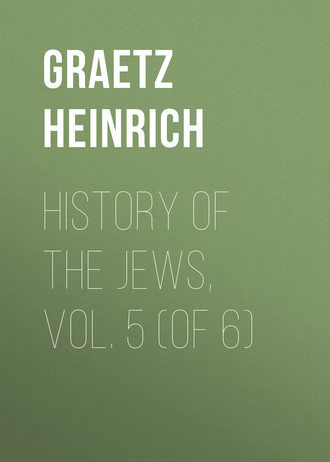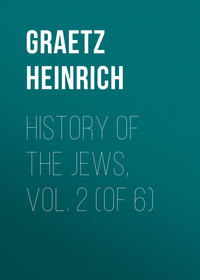
History of the Jews, Vol. 5 (of 6)
These victories were followed by a retrograde movement. The laws which the Hellenist apostates had daringly broken, and on account of which so many martyrs had fallen, even those laws which had been superadded as a fence, were henceforth yet more zealously and scrupulously practiced. Judaism assumed an altered Pharisaic (i. e., punctilious) character. For a portion of the people, the over-scrupulous (Assidæans), even this was not sufficient. They imagined that only by retirement from the world could the laws be strictly followed, and therefore, under the designation of Essenes, they separated from the rest, and followed their particular mode of thought and peculiar observances. The more worldly, such as the warriors and statesmen, offered sharp opposition to such asceticism, and rejected the additional ordinances which were not justified by the letter of the law. Hence arose the division into Pharisees, Essenes, and Sadducees, which was one of the results of the Maccabæan war. Internal dissensions ensued, and facilitated the subjugation of Judæa by Pompey and the Roman legions, and the political independence of the Judæans under their own king, which had been maintained during a century, now came to an end.
Unfortunately, the Romans appointed their protégé, Herod, to be king, and he instilled his venomous ideas into the hearts of the Patriarchs. In order, to some extent, to shield the populace from the alienation desired by the Herodians, the exclusive laws, more particularly the ritual ordinances, were made more stringent. This was the work of Hillel and Shammai. Further, fanatical zeal was displayed in commemorating the liberty which had been disgracefully forfeited; this was the work of the founder of the zealot party – Judah of Galilee – with whom the Shammaites were to some extent connected. The zealots incited the whole nation to wage fierce war against the Roman conquerors of the world, but their attempt ended in the destruction of the community and of Jerusalem, and the greatly-revered Temple was laid waste. It is, however, a marvelous fact that the nationality and the religion did not perish, but survived the destroyers, Vespasian, Titus, and their successors, as they had survived Nebuchadnezzar and his dynasty. The populace was rescued through the law, which had become its very soul. The Synhedrial school-house now became the center, but the law had totally changed in aspect.
Masses of new religious enactments now overlaid the law; fences, Synhedrial enactments, customs dating from more ancient or from recent times, which had been orally delivered, and had accumulated to an immense extent. These oral Halachas, as they were termed, ranked, if not higher than, certainly equal with, the written laws.
The Sadducæan opposition to these laws had ceased; young Christendom, which had sprung from the lap of Judaism, or, to speak more correctly, from Essenism, enhanced the value of the highly-prized and overrated laws, and was indifferent to their origin. In contradistinction to the Judæo-Christians, who thought that they could merge the old laws with the new faith, the apostle Paul created the Pagan-Christian idea, which rejected every prescription of the law as entrammeling, and proclaimed evangelical liberty. This attack on the law, and the mystic formulas evolved by the Gnostics from the letters of Holy Writ, caused all that bordered upon religious precepts to become more precious and to be more rigidly observed in Judæan circles.
The transmission of Halachic doctrines had been endangered by the divergence of opinion between the disciples of Hillel and of Shammai regarding their scope, limits, justification, and applicability, and in consequence of the fatal termination of the disastrous war. Those teachers of the law who had survived the catastrophe were the more eager to hand down such laws, which they claimed to have transmitted faithfully, and to rescue them from oblivion. Youths and men, now rid of political cares, thronged to the celebrated colleges in order to impress on their memories the traditions handed down to them. They vied with each other in teaching and learning. But this eagerness did not crush out zealotism and a desire to take up arms in the cause of freedom. Fiery youths, especially the disciples of the school of Akiba, quitted the school-house in order at an opportune moment to carry on a bloody feud with the Roman legions – in the first instance this occurred under Trajan, scarcely half a century after the fall of Jerusalem, and again two decades later under Hadrian. These attempts ended disastrously; Hadrian instituted a system of persecution directed more against Judaism than against the Judæans, and especially against teachers and disciples, in the hope of destroying the Law, the very soul of the nationality, but he did not succeed in his object. The fiery zeal for the traditional law was increased through the activity of Akiba's disciples, who had returned from exile.
The center was, however, transferred to Galilee, as Judæa, the southern portion of the country, had been laid waste, and was chiefly in the possession of pagan colonists. Here was situated the Patriarchate which represented the unity of the people, the post of Patriarch being occupied by a descendant of Hillel, who, as it was alleged, came from the royal house of David, and who, from the tiny territory of Galilee, from Sepphoris and Tiberias, governed the numerous communities of the Diaspora – beyond the land and the sea, in Egypt, Babylon, Asia Minor, and Europe. His encyclicals, which were sent by special messengers, were greeted with respect, and were obeyed like those of a spiritual chief. The Mishnah, the fundamental text of the voluminous Talmud, a collection of Halachic laws, and species of "corpus juris civilis canonici," which was compiled by the Patriarch Judah I, owed its universal recognition to that cause. This spiritual greatness, however, was destroyed through Byzantium, from the time that the Roman Empire worshiped, or was compelled to worship, Jesus instead of Jupiter, and the fanatical persecution practiced mutually amongst the Christian sects was visited upon the Jews.
The Byzantine emperors, Constantine, Theodosius II, and Justinian, treated the sons of Jacob even more mercilessly than their heathen enemies. They deprived them of their Roman rights of citizenship, of their rights as men, and also encroached upon their freedom in religious practices. This example was followed by the rulers in various European countries, more especially in France and Spain.
Fortunately, there had been formed a new center in another quarter, on the banks of the Euphrates and Tigris, where numerous Judæan communities occupied a favorable position, and lived almost in a state of political independence, under their own Judæan prince, the Exilarch. The schools which were here established replaced those which had been destroyed in the Holy Land. These schools exercised authority over the entire Jewish community, with but few interruptions, during seven hundred years. Here there arose the Babylonian Talmud, which was more fortunate than its companion-work, the Palestinian or Jerusalem Talmud, a religious code of a peculiar kind. This work with its phases of light and shade exercised an influence in Jewish circles (which continues to the present day), and it almost over-shadowed Holy Writ. Here also Talmudical dialectics became developed, and endowed the Jews who stood beneath the spell of the Talmud with peculiar characteristics, especially imbuing them with that love of hair-splitting which afterwards deteriorated into sophistic subtlety. The authority of the Talmud, however, was to some extent lessened through events which occurred on the Arabian Peninsula. Mahomet, the son of Abdallah, from Mecca, had established the Islamite religion on the basis of various fragments of Judaism. The Arabs at first lived on friendly terms with the Judæans who dwelt in their land, and who were warlike, lovers of freedom and of song, and superior to the Arabs by reason of their possession of Holy Writ. Mahomet, however, having been derided by them, afterwards waged war against one Judæan tribe after another, and exiled them from Arabia, which proscription was upheld by Caliph Omar.
The exiles settled in Palestine and Babylon, where they became acquainted with tribesmen and co-religionists, who, having followed the Talmudical precepts, had acquired totally different habits. They found the Talmudical restrictions incompatible with their hereditary and unquenched thirst for liberty. This Judæo-Arabic circle declared war against Talmudism. The contest, which in the first instance was only of a mild character, the needful ability to sustain it being wanting, afterwards became fiercer, when Anan, a connection of the Prince of Captivity, eagerly joined in the fray, asserting Holy Writ to be the sole source of religion, and the Talmud to be only the work of man.
Thus arose a new sect, the Ananites, or Karaites. Although small in numbers, yet by their energy and combativeness they aroused the less active minds, and stimulated the desire for a knowledge of Holy Writ, which had hitherto fallen into neglect. The impulse given to this study was so powerful that Saadiah, the representative of a Talmudical school, devoted his entire attention to it. Through him a philosophical tendency was introduced into Judæan circles. Until this time, as in Christendom and Islam, a belief in existing authorities had caused it to be considered heretical to speculate upon religion.
From Babylon there now emanated a spark of rational thought and scientific inquiry, which traveled as far as the Pyrenean Peninsula. This territory, being under Mahometan rule, was connected in spirit with the East. A long succession of eminent personages had during two centuries fostered and cultivated a spirit of deep research in Spain, whilst in Christendom a fanatical desire for persecution resulted in the destruction of the Jews, or in their banishment from the homes which they had possessed for so long a time. The culminating point of philosophical thought was attained by Moses Maimuni, who for centuries was "the Guide of the Perplexed," and who also, under the sanction of the Church, exercised a powerful influence on Dominican scholasticism. Where there is great light there must also be much shadow. The shadows caused by the light which had proceeded from Maimuni became embodied in the vagaries of the Kabbala, which confused the minds of the multitude by its forgeries, and corrupted the feelings by its excesses.
A deep gulf was created in Spain and Southern France between the Maimunists and anti-Maimunists, between faith based upon intellectuality, and faith based upon authority. This schism would have given rise to sectarianism, had not the accumulated sufferings of the people riveted their attention on what was proximate – the misery of all. Faith in authority proved victorious, under the influence of the Kabbala, and every scientific pursuit, excepting that of medicine, was proscribed in Spain, as if it were intended to undermine the continuance of Judaism. The fourteenth century ignored the tenth century. Solomon ben Adret, who had solemnly pronounced an interdict against philosophy, ranked Saadiah as to some extent a heretic. It seemed as if, with the decay of knowledge, the glory of the Spanish Jews were to be entirely extinguished.
The cup of sorrow, drained by the Jews throughout Central Europe – from the Rhine to the Vistula, and from the Alps to the marsh-lands of the German Ocean – in consequence of the Black Death, as if they had indeed been poisoners, also reached the Spanish Jews. Their grandees, who had been employed at the court as ministers of finance, diplomatists, private secretaries, or court physicians, were powerless to protect them, as they had formerly done.
The horrible massacre in 1391 had driven many Jews, with wild despair in their hearts, into the arms of the Church, and they deceived themselves with the idea that they could outwardly join the Church, whilst remaining inwardly faithful to the God of Israel.
Thus arose the Marranos. Their fanatical persecutors, however, knew no peace until they had succeeded in arousing the thunders of the Inquisition against the Jews, in lighting the stake, in causing them to be banished from Spain by hundreds of thousands, and in enforcing compulsory baptism in Portugal. But the Inquisition and the stake in both of these countries only awoke a deeper love for Judaism in the hearts of the Marranos. Great as was the number of those who perished at the autos-da-fé, or who pined away in prison, yet their offspring, who secretly continued to cherish their own faith at the risk of their lives, after one or two centuries sought to escape from the hell on the Pyrenean Peninsula.
Under the guise of Spanish or Portuguese merchants, they founded large communities in Bordeaux, Amsterdam, London, and in various parts of Italy. From their step-fatherland they brought with them a higher culture and an aristocratic demeanor. Consequently they did not suffer from the contempt with which other Jews were treated in political and social circles. In fact, the Jews of Marrano descent looked down upon their co-religionists as gypsies, on account of their external deterioration. With marvelous rapidity, however, did those who were considered as gypsies regenerate and elevate themselves; and, what was more marvelous, this change did not proceed from the aristocratic Sephardim. The personage to whom this transformation was due sprang from the midst of those who were so despised and contemned. He bore no trace of culture in his youth, but was deformed, awkward, and shy – this was Moses Mendelssohn, from the petty community of Dessau. Had the call reached him to become the leader of his co-religionists, he would have replied, like the great Prophet in Egypt – "Who am I?" It is remarkable that Mendelssohn, without desiring or intending to do so, paved the way for the emancipation of the Jews and the purification of Judaism. The present age has given the lie to the assertion of Jew-haters (who at the close of the eighteenth century and commencement of the nineteenth century were numberless), that generation after generation must pass away before any improvement could be expected in the debased condition of the Jews.
In two decades there appeared on the canvas of History a series of noble, if not of ennobled Jews, in Germany, France, Holland, and Italy, and these ranked as high as if they had been of equal birth with Christians of the aristocratic class.
The historic course of the Israelite nation not only shows, as with other nations, the stages of growth, bloom, and decay, but it exhibits the extraordinary phenomenon that the decay was succeeded, on three different occasions, by a new budding and blossoming time. The history of the crystallization of the Israelite family group into a nation, and their entry into the land of Canaan, until the establishment of a kingdom, constitutes the growth. The stage of bloom was in the days of the kings David and Solomon, who raised the condition of the Israelite people to that of a state of the first rank. The period of blossoming was short, and was followed by loss of power and by the downfall of the nationality. But again it gradually revived under the rule of the Persians and Greeks, developed under the Maccabees, only to decay away under the Romans. This decay, however, was merely superficial, and was destined to give place to a resuscitation in another form.
One of the prophets has represented the growth of the Israelite nation in Egypt by the picture of a deserted female child left lying in the fields, begrimed with blood and filth, but who, notwithstanding her desertion and misery, develops into a blooming maiden. The development of the race in Babylon is described by another prophet under the image of an unhappy and sorrowing widow, who has been robbed of her children, until, on the unexpected return of her numerous offspring from all ends and corners of the earth, she is comforted, and regains her lost youth with them. For the third rejuvenescence of the Jewish race tradition has likewise found a fitting picture.
At the gates of Rome there lies a human form, clothed in rags, leprous, half dead, an object of horror and pity. Suddenly this abject figure is touched with a staff, on which biblical sentences are inscribed. He rises, his hideous coverings and disfigurements vanish, and he stands erect in the beautiful glow of youth. Similes are but lame, and give no adequate representation of a phenomenon to which there is no equal in every-day existence. In any case, the Jewish nation is an extraordinary phenomenon, dating as it does from hoary antiquity, but possessing youthful vigor, having passed through numberless vicissitudes, yet remaining ever true to itself.
1
The author of this work was, together with Frankel, one of the original founders. (Note by the Author.)
2
A Theological-Jewish Faculty, an offshoot of the University, and a Jewish Academy are still needed. (Note by the Author.)





